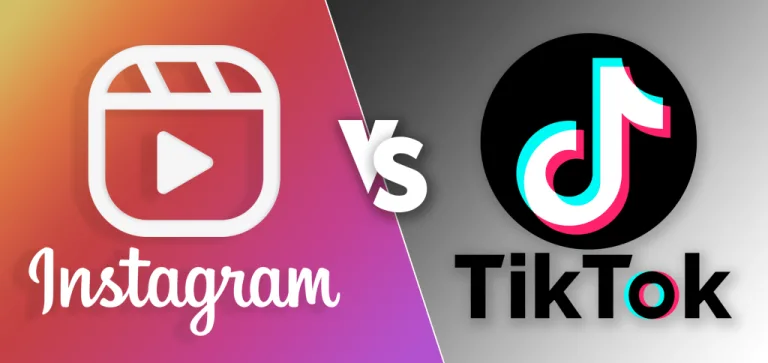TikTok vs. Instagram Reels: What’s the Difference?

The rise of short-form video content has taken the world by storm, with TikTok and Instagram Reels at the forefront of this digital revolution. While both platforms offer users the ability to create, share, and engage with short videos, there are distinct differences between them. This article explores the key contrasts between TikTok and Instagram Reels in terms of functionality, audience, features, and overall user experience.
1. Platform Origins and Core Purpose
- TikTok: TikTok, launched in 2016 by Chinese tech company ByteDance, quickly gained popularity as a platform dedicated entirely to short, creative videos. With a focus on viral trends, music, and user-generated content, TikTok has built a massive global user base, becoming a hub for memes, challenges, and diverse entertainment.
- Instagram Reels: Instagram Reels was introduced in August 2020 by Instagram (owned by Meta) as a direct response to TikTok’s success. Instagram, originally a photo-sharing app, integrated Reels as a feature within its existing platform. Reels allows Instagram users to create and share 15-60 second videos, adding to the already established photo, Stories, and IGTV options.
2. User Interface and Experience
- TikTok: TikTok’s user interface is simple and centered around video discovery. The “For You” page is algorithm-driven, presenting users with a personalized feed of content based on their interactions and interests. Users can easily swipe up for the next video, which encourages continuous engagement. The app’s editing tools are prominent, allowing creators to seamlessly add effects, filters, transitions, and music.
- Instagram Reels: Reels is integrated into Instagram’s broader platform, making its user experience more multifaceted. While there is a dedicated Reels tab, users can also access Reels through their main Instagram feed or profile. Instagram’s algorithm prioritizes content from followed accounts but also features a “Discover” section, where users can find trending Reels. The editing tools are somewhat similar to TikTok, but with less emphasis on advanced video effects.
3. Audience and Demographics
- TikTok: TikTok’s audience skews younger, with a significant portion of its users between the ages of 16-24. This demographic gravitates toward viral trends, challenges, and humorous content. TikTok has become synonymous with Gen Z culture, making it the go-to platform for youth-centric brands and influencers looking to reach this age group.
- Instagram Reels: Instagram’s user base is more varied in terms of age, with a significant percentage of users in the 18-34 age range, but also including older demographics. Since Instagram was already well-established before Reels, its users tend to be more diverse in terms of content preferences, including lifestyle, fashion, fitness, travel, and more. Reels caters to a broader audience than TikTok’s primarily youthful demographic.
4. Content Discovery and Algorithms
- TikTok: The power of TikTok lies in its algorithm, which delivers hyper-personalized content to users based on their behavior and interests. The “For You” page showcases videos from creators that users may not follow, but the algorithm calculates what will likely capture their attention. This system allows any user, even with few followers, to potentially go viral if their content resonates with the right audience.
- Instagram Reels: Reels relies on Instagram’s existing algorithm, which emphasizes content from accounts users follow, alongside some promoted Reels from trending creators or brands. While Instagram’s algorithm is still powerful, it tends to favor established accounts with more followers and engagement, making it somewhat harder for smaller creators to achieve the same viral success that TikTok offers.
5. Music and Audio Features
- TikTok: Music is a core feature of TikTok, and the app boasts an extensive library of songs, sound effects, and user-generated sounds. Creators can browse trending sounds and add them to their videos, and TikTok’s challenges often revolve around specific songs or audio clips. The platform encourages remix culture, where users can take a popular sound and create their own version of it.
- Instagram Reels: Instagram offers a smaller but growing music library, and users can also add their own original audio to their Reels. The platform has been expanding its music options, but it does not have the same emphasis on sound-driven challenges and trends as TikTok. Reels are often more focused on visuals or lifestyle content rather than music-led creativity.
6. Video Length and Editing Tools
- TikTok: TikTok videos can be up to 10 minutes long as of 2022, although the platform’s signature is still the 15-second to 3-minute video format ,Buy TikTok Views ,TikTok’s editing tools are robust, offering users advanced features like green screen effects, AR filters, voiceovers, and transitions. The app encourages creativity and experimentation, which is part of its appeal.
- Instagram Reels: Reels initially launched with a 15-second video limit, but it has since extended to 60 seconds. Instagram’s editing tools are somewhat less advanced than Tik Tok, focusing more on simplicity and ease of use. Reels offer standard filters, text, and basic transitions, but they don’t have the same level of creative options as TikTok.
7. Advertising and Monetization
- TikTok: TikTok has rapidly expanded its advertising options, allowing brands to run ads between videos or sponsor trending challenges.Buy TikTok likes TikTok also introduced its Creator Fund, which compensates creators based on views and engagement. TikTok’s influencer marketing ecosystem is thriving, with many creators monetizing their content through brand deals, merchandise, and sponsorships.
- Instagram Reels: Instagram, as part of the larger Meta ecosystem, integrates Reels into its advertising suite, enabling brands to run ads within Reels and promote them across Facebook and Instagram. Instagram also introduced ways for creators to monetize Reels through affiliate links, branded content, and shopping integrations. However, Reels lacks a dedicated creator fund like Tik Tok.
8. Global Reach and Cultural Impact
- TikTok: TikTok’s cultural impact has been immense, shaping global trends and launching viral challenges that cross borders. The platform’s algorithm creates a more global experience, where trends spread rapidly regardless of geography. TikTok is a leader in creating micro-celebrities and has contributed to the rise of global influencers.
- Instagram Reels: Reels operates within Instagram’s existing user base, meaning its cultural impact is more tied to established Instagram influencers and celebrities. Reels’ trends tend to be more localized and reflect Instagram’s emphasis on curated, aspirational content. However, its integration with Instagram’s shopping features has made it a powerful tool for e-commerce and influencer marketing.
Conclusion
Both TikTok and Instagram Reels are powerful platforms for short-form video content, but they cater to slightly different audiences and use cases. TikTok excels in creativity, viral trends, and music-driven content, making it ideal for younger users seeking entertainment and cultural moments. Instagram Reels, on the other hand, fits seamlessly into Instagram’s broader ecosystem, serving a more diverse audience with an emphasis on lifestyle and curated content.
For users and creators, the choice between TikTok and Reels largely depends on personal preferences, goals, and target audiences,BuyCheapestFollowers Many brands and influencers choose to use both platforms strategically to maximize their reach and engagement in the evolving social media landscape.



